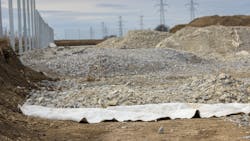Many construction site activities cause severe erosion by disrupting and eliminating the root systems and natural vegetation that hold soil in place. While this process can occur naturally, humans often exacerbate it with increased site traffic and excavation work. Fortunately, geotextile erosion control measures can curb these effects.
Geotextiles are synthetic and permeable materials that increase soil’s natural characteristics, aiding in drainage and reinforcing vulnerable areas. You can buy them in woven, non-woven and knitted varieties and various thicknesses. A clearer idea of your intended use case and the construction project’s scope will help you make the most appropriate decisions.
Pursuing sustainable and biodegradable geotextiles
People are continually looking for innovations that make geotextile erosion control methods more suitable for long-term applications. Some efforts have also explored options that allow geotextiles to biodegrade after use, providing sustainable possibilities. One downside is that biodegradable materials may not last long enough before starting to break down.
However, German researchers recently developed a bio-based protective coating that extends the geotextile lifespan while meeting eco-friendly aims. The team derived their innovation from lignin and confirmed it does not deposit microplastics in the soil when breaking down. Lab tests also showed the coating remains intact for at least 160 days after burial.
The researchers hope their work will reduce dependence on petroleum-based products used for geotextiles. Another advantage of this approach is that lignin was formerly a waste material. Using it for a sustainable invention opens new opportunities.
Combining geotextiles with tire scraps
People are also exploring real-world alternatives for using geotextiles in sustainable projects. Erosion is a frequent risk associated with road construction projects. When poorly controlled, it can introduce soil runoff to local waterways or cause blockages that add hours to established time frames.
One Michigan road construction project highlighted a creative way to prioritize sustainability while using geotextiles. Workers used 30,000 scrap tires under several hundred feet of road. They also interspersed the tire layers with geotextile fabric. Previously, erosion caused the road to sink. While adding more asphalt to address the problem accelerated the issue, this geotextiles solution should prevent it.
Construction industry analyses suggest sector growth of approximately 11% by 2028. Creative solutions like geotextiles should encourage people to explore eco-focused geotextile erosion control as they commit to new projects.
Using geotextiles for golf Course construction and renovation
Although erosion often happens during construction, workers must also think proactively to reduce its effects after a project’s completion. This issue commonly occurs in golf course construction because the land used for these projects is often already at an increased erosion risk.
Much like how construction machinery can worsen erosion, golf carts exacerbate the issue as well. When construction sites are future golf courses, geotextiles are critical for preventing erosion during and after the work.
Geotextiles became a central part of the construction of a Scottish golf course when people used them to line drainage trenches. Thinking outside the box was necessary because of extremely wet course conditions, requiring an advanced infrastructure to handle them. Construction equipment fell into a peat bog during earlier development efforts, so the team proactively discussed wetness management options. They also wanted to minimize disruption to parts of the property left unchanged during this project.
Geotextiles curb coastal erosion but may cause pollution
Knowing what happens to geotextile materials after construction projects finish is essential to protect the planet and prevent unintended consequences. In one case, researchers studied whether several synthetic materials break down in ocean water. One was polyethylene terephthalate, a polyester often used in geotextiles.
The team submerged the samples for 231 days at the sea’s surface and 196 days on the seafloor. Unfortunately, the materials degraded at drastically different rates — even some bio-based samples contributed to microplastic pollution in the ocean.
Geotextiles as protective measures
Such results are important for informing decisions about construction projects near coastal areas. One project at the Indian port of Valiathura involves combining geotextiles with a 30-meter sea wall. Seasonal erosion at the site is so severe that fishing boats can no longer use the port, resulting in economic losses for the community. The coastal damage has forced some residents to evacuate their homes and use emergency accommodations.
Some construction professionals also choose geotextile erosion control as a stopgap measure before beginning more expansive, long-term plans. That is the approach taken with a federally-backed program by the U.S. Army Corps of Engineers. The Corps has planned a reinforcement project for Montauk, a village in Long Island, New York. They previously reinforced the shoreline with temporary geotextile sandbags.
However, construction on a permanent solution will soon start. It concerns creating a barrier with 450,000 cubic yards of sand, protecting the area from severe storms and other climate change-related effects. This project demonstrates how geotextiles can be both short and long-term solutions for construction projects.
Many engineers, architects and others take inspiration from nature when creating new structures. They must also understand nature’s trends, especially when determining if geotextiles will suit upcoming projects.
How will you benefit from geotextile erosion control?
Using geotextiles can help construction crews minimize erosion, including by providing slope protection and aiding runoff control. However, anyone overseeing the project must ensure they use these options alongside other best practices.
Segmenting the construction site and using erosion preventives in each area allows for the use of a progressive approach. It also helps to stabilize the construction site entrances with crushed stone paths. The material can reduce soil disturbance in those highly trafficked areas. While geotextile use can bring significant benefits, these materials are most impactful when applied thoughtfully and with other methods.






